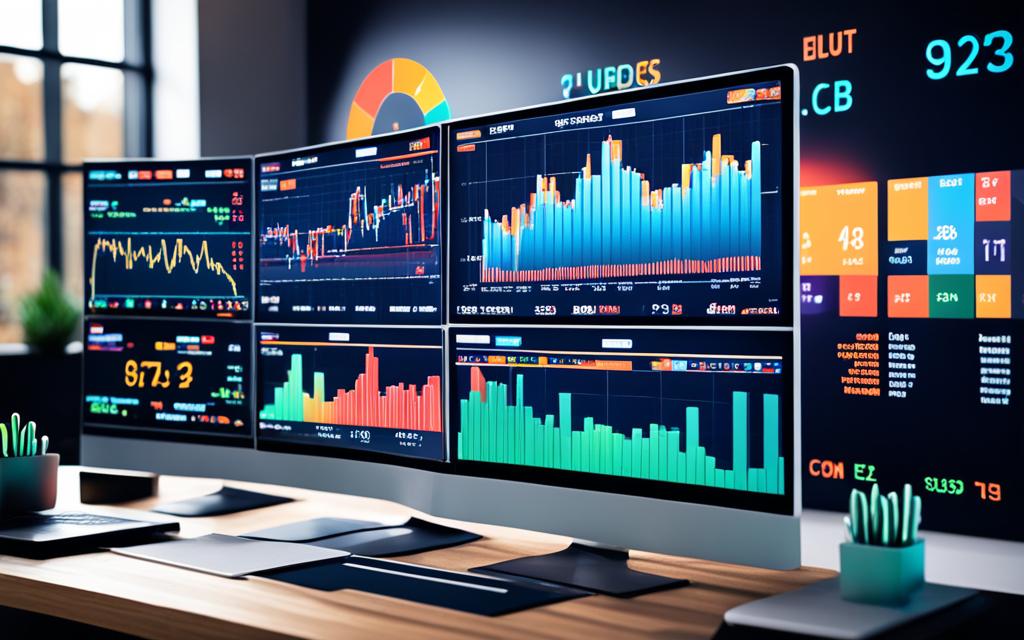Table of Contents
The cryptocurrency market is always open, 24/7, which is different from traditional stock exchanges and bond markets that close1. This means you can trade cryptocurrencies at any time, even on weekends and holidays. Although, the market hours for specific crypto assets may vary, the main market is open all the time.
Key Takeaways:
- The cryptocurrency market is open 24/7, allowing investors to trade at any time.
- Cryptocurrencies can be bought, sold, and traded even on weekends and holidays.
- While some crypto assets may have varying market hours, the spot market for cryptocurrencies remains open around the clock.
Understanding Crypto Trading Hours
The cryptocurrency market is always open, 24/7. This means you can trade digital assets any time you want. But, it’s key to know when trading is most active to make the most of your experience1.
Cryptocurrencies aren’t like stocks with clear trading times every day. They are traded all day and all night. This open market lets people from all over the world trade without limits.
Most cryptocurrency trades happen when the markets globally are open. But, did you know, around 35% of trading is during weekends? This shows a significant amount of activity happens when most people are not working. So, it’s smart to trade when markets are most active, for better chances to buy or sell easily.
Data from Skew shows that the busiest time for cryptocurrency trading is 3-4 PM UTC. Platforms like Coinbase see a lot of activity then, with an average trading volume of $6.5 million1. This time is good for those in Europe after lunch and people in North America in the morning, just as the U.S. stock market opens.
Another busy trading time is 10-11 AM Eastern Standard Time. This time matches the start of the U.S. market, causing more activity1. But remember, trading can be very up and down, reacting to world events and economic news.
Even though cryptocurrency markets are open all the time, some trading options like CFDs might have specific hours1. It’s important for traders to know when they can trade these assets for a smooth experience. This way, they can avoid any interruptions.
When looking at price changes and how unpredictable the market is, some days and times stand out. For instance, Wednesday at 4 PM UTC is when trading can get wild, while Monday mornings are often calmer1. This information can help traders plan their moves to catch more opportunities during busy times.
| Key Takeaways |
|---|
| 1. Cryptocurrency markets operate 24/7, allowing traders endless opportunities to engage in digital asset trading. |
| 2. Trading volume and liquidity vary throughout the day, with peak trading times offering increased opportunities for traders. |
| 3. The most intense trading times range from 3 PM to 4 PM UTC, corresponding to the opening of the U.S. stock market. |
| 4. Trading volume and market movements can be highly volatile, influenced by various factors, including global economic news and events. |
| 5. Crypto CFD trading platforms may have specific trading hours for different crypto assets, necessitating awareness and preparation from traders. |
Knowing the best times to trade cryptocurrencies can help you make better decisions. By trading when activity is high, you have the chance to make your moves at the best prices. This can mean better profits for you.
The Impact of Global Market Hours
Studying how global market hours affect the crypto market shows that crypto trading often overlaps with normal market hours. In the United States, trading in cryptocurrencies like Bitcoin is highest when the U.S. stock market is open. This shows that trading has moved from Asia to the West.
Thanks to the worldwide nature of cryptocurrencies, trading can happen at any time, everywhere. The crypto market is open 24/7, so anyone can trade at a convenient time, including outside of regular market hours.
“The trading volume of cryptocurrencies, such as Bitcoin, is most pronounced during U.S. stock market hours.”
Traders who follow global market hours can use this to their advantage. They can spot trends and movements more easily during normal stock market hours. Knowing when the market is most active can help them make smarter trades and increase their chances of making money.
But, remember, the crypto market is always open. This constant access brings both benefits and challenges. It offers traders more flexibility and the chance to invest at any time. This is great for those with busy schedules or in different time zones.
Being available all the time also helps keep the market moving. Prices can be discovered and big trades made without distorting the market. Yet, this freedom comes with risks, like the rapid changes in prices linked to market emotions and new technology advances.
In late 2017, cryptocurrency values surged during a stock market boom, with Bitcoin almost hitting $20,000. This shows how global market feelings can strongly influence crypto prices.
“In late 2017, cryptocurrency prices surged as traditional stock markets experienced a bull run, with Bitcoin reaching close to $20,000.”2
The stock market crash of March 2020, caused by COVID-19, saw a big drop in crypto prices. This shows how closely tied the crypto market is to major global events.
“The global stock market crash in March 2020, triggered by the COVID-19 pandemic, led to a sharp decline in cryptocurrency prices.”2
When trading crypto, it’s key to consider all angles. Things like changes in rules, fraud, or sudden shifts in mood can cause market swings. So, always do your homework and assess the risks before trading.
But, there are also positive forces, like new rules that help the market grow, technology gains, and big events. These can fuel market booms and offer trading chances.
“Positive regulatory developments, institutional adoption, market integration, halving events, technological advances, and geopolitical factors are factors behind crypto pumps.”2
Overall, knowing the effect of global hours on crypto trading is very important. It lets traders make the most of the market, being aware of both everyday trends and the continuous opportunities worldwide. This understanding helps navigate the digital asset world more effectively.
Best Time for Crypto Trading
Timing is key in crypto trading. Knowing the right time to trade can make a big difference. It lets traders make the most of market changes. Data from many sources helps us understand the best times for trading digital currencies.
The most active time for trading is usually between 8 a.m. and 4 p.m. UTC. This time fits both European and U.S. trading hours3. It sees a lot of trading, which means there’s more chance to make good trades.
Between 10 and 11 AM EST is when trading heats up on big platforms like Coinbase3. This is worth knowing because it links to high trading volume. High volume means more chances to make money. So, it’s a good time to be active in the market.
Everyone has their favourite time for trading. But aiming to trade when the market is most active is wise. Your choice might depend on when you’re free to trade and where you are in the world.
The Impact of Trading Patterns and Volatility
Trading is often best when the market is moving a lot. This is what we call volatility. Being aware of this and knowing how to use it can help traders a lot.
When there are more trades and the market is busier, prices can change quickly. This opens up chances for traders to make fast profits3. For those watching the market closely, there are opportunities to make money when prices change quickly.
Looking at different time frames is a smart strategy. It lets traders see more and understand how prices might move. This can help identify good trading times.
Good trading times are when there is a lot of trading and prices could move a lot. But don’t forget, news and events can also change the market. So, it’s good to keep an eye on these too.
Trading Timeframes and Market Focus
| Timeframe | Cryptocurrency | Market Focus |
|---|---|---|
| Morning hours | Bitcoin | U.S. stock market trading hours4 |
| Evening hours | Ethereum, Uniswap | Both centralized and decentralized exchanges show increased activity4 |
In the table, we see Bitcoin’s trading activity peak during U.S. stock market hours4. This got even stronger in early 20224. For Ethereum and Uniswap, trading picks up in the morning and goes up until the evening4.
Knowing about these trading patterns can give traders an edge. It shows where the market is focusing its attention.
For the best chances in trading, aim for times when the market is lively. Making your trading plans around these busy times can be smart. By understanding the market’s movements and having a plan, success in trading is more likely.
Volatility in Crypto Trading
Cryptocurrency trading is full of ups and downs. It works every hour of every day. This means anyone can trade at any time. All this coupled with other factors makes the market very unpredictable.
The volatile time for cryptocurrency changes due to global time differences and events. Knowing these changes is key for smart trading and surviving the crypto world’s chaos.
The Impact of Global Market Hours
The world’s trading times affect how volatile cryptocurrencies are. For example, many become most unpredictable on Wednesdays at 4 PM UTC5. This matches the US stock market’s busiest time, around midday. In contrast, Mondays from 8 AM to 10 AM UTC are often calmer5. This suggests traders can see more action and chances on certain days.
“The most volatile time for several cryptocurrencies, including Bitcoin, is Wednesday at 4 PM UTC, while Monday between 8 AM to 10 AM UTC is generally considered the least volatile period”5.
Best Time for Crypto Trading
Figuring out the best trading times means looking at many factors. This includes global times and market trend data. Checking the Fear and Greed Index, which shows market feelings, can also help5. High levels on the index suggest market greed.
Dealing with market ups and downs requires good strategies. People use methods like Dollar Cost Averaging and setting stop-loss orders6. Also, tools like moving averages can make managing the market’s bumps easier6.
Trading Cryptocurrency on Weekends
Weekends in crypto trading can be different. Trading volume for Bitcoin often drops then7. This is because professional traders are less active. But, Bitcoin’s prices can still change a lot on weekends, just like weekdays7.
Trading on weekends demands extra care with risks and liquidity issues. It’s important for traders to be cautious and well-informed.
In conclusion, smart trading in a volatile market needs deep knowledge and good analysis. By understanding trading times, using the right strategies, and managing risks, traders can handle the crypto market’s swings and find chances to win.
Impact of Crypto CFDs
The cryptocurrency spot market runs non-stop, but crypto CFDs have specific trading times8. This means traders get regulated products for crypto trades. Unlike direct crypto trading, where you can invest in many coins, CFDs offer a wider range. This helps in diversifying and seeing more market chances9.
Crypto CFDs let you trade with leverage, which can help both make and lose more money109. Some CFDs allow trades that are 5 times bigger than what you have. But, being careful is important. Start small, check risks, and use stop-loss orders to keep losses in check89.
Trading CFDs also means less hassle with the technical parts of cryptocurrencies9. It’s an easier way to join the crypto world and benefit from its growth9. Plus, you don’t need to make an exchange account, which speeds up getting started. Platforms like Axi let you trade CFDs in minutes thanks to quick online checks10.
Trading crypto CFDs has its costs, like broker fees and extra charges for opening and closing positions8. But, regular crypto trading has fees for each trade and when you take money out8. Think about these fees and what best fits your trading goals8.
The rules for trading CFDs can change depending on where you are8. It’s key to know the rules and protections for your trading safety9. Trading CFDs on platforms like Axi can offer better liquidity and faster trades. This is because their prices come from many sources10.
Crypto CFDs offer a regulated path to trading digital currencies with some advantages89. They let traders use risk management and analysis tools. As the worlds of cryptocurrencies and CFDs meet, the industry is set to grow more9.
Trading Cryptocurrency on Weekends
The cryptocurrency market is open 24/7, unlike many financial markets. This means traders can buy and sell cryptocurrency on weekends. While this offers unique chances for profit, it also poses challenges.
Weekends in the crypto world can be fast-paced because big players and automated trading step in. They make use of the smaller number of trades, leading to sudden price jumps and more erratic price changes11. But remember, trading on weekends does have its own set of issues to keep in mind.
One thing to think about is the availability of assets. Because there are fewer trades, the amount of assets changing hands is less than usual. This can cause the difference between buy and sell prices to grow, which might cost you more11.
Even with these challenges, everyday traders can jump into the action on weekends. Top platforms like Binance and Coinbase let you trade cryptocurrencies even on Saturdays and Sundays11.
Weekend trading can fit certain strategies well. For instance, if you hold onto assets for a short while, the increased unpredictability might create more chances to gain11.
However, the risks are still there. The crypto space, especially on weekends, is sometimes a target for scams. Stay cautious and only get involved with known and trusted sites and projects11.
Trading might be more touchy on weekends due to certain events. For instance, if there’s a rush to sell, but banks are closed, it can make prices drop more. This lack of bank support can change the way the market moves12.
Personalities like Elon Musk can also shake things up with what they post online over the weekend. It’s important to keep an eye on news and trends, even when the market’s quieter12.
If you’re into margin trading, watch out for big shifts in prices over the weekend. They could prompt a forced sale of your assets if you’re not careful. Always be vigilant and know the risks involved in margin trading on weekends12.

| Pros of Trading Cryptocurrency on Weekends | Cons of Trading Cryptocurrency on Weekends |
|---|---|
|
|
On the whole, weekend trading can offer extra chances to make money and allows access when other markets are shut. But, it’s important to be aware of the unique challenges and risks, like lower trading volume and the potential for scams. Doing your homework and managing risk well are critical for successful weekend trades.
Factors Affecting Crypto Trading Fees
When trading cryptocurrencies, it’s key to know what affects the fees. This knowledge helps traders save money and make smart choices. Here are the main things that shape trading costs:
- The type of fees matters a lot. You might face charges for moving funds, making trades (maker/taker fees), a set fee for each trade, or fees that change with your trading amount13.
- Your trade volume has a big impact on fees. At big names like Coinbase, how much you trade affects fees. For instance, trades under $10,000 can see 0.60% for takers and 0.40% for makers. But, $50,000 to $100,000 trades get lower fees13.
- How much you’ve traded over 30 days also matters. Exchanges want you to trade more often and more. This means fees may go down the more you’ve traded over time13.
- Different exchanges, different fees. Take Binance for example. It bases fees on how much you trade. Plus, U.S. users have fewer coins to trade than the global version of Binance13.
- Some exchanges change their fee levels each hour. Coinbase does this based on recent trading. This can make your fees go up or down, depending on your trading level13.
- Most regulated exchanges lower fees as you trade more. This could be part of their incentives for big traders13.
For traders, knowing these fee factors is very important. By looking at how much they trade and where, they can cut their costs and increase their gains.
Now, let’s look more at how trading fees differ. They can be anywhere from 0.1% to over 1%, depending on the exchange14. Also, things like a busy network can raise Bitcoin’s transaction costs. Gas fees from Ethereum often change, affecting costs for doing deals on the blockchain14.
With these points in mind, traders should look closely at exchange fees. Understanding fee setups and issues like network business can help make better trading choices. This is crucial for boosting profitability and avoiding unnecessary costs.
Pros and Cons of Non-Stop Crypto Trading
Crypto trading’s non-stop action is loved by traders worldwide. It lets them trade anytime they want. This means they can take advantage of market changes quickly and potentially earn more money. The opportunity to trade 24/7 is a big plus for many people.
Another great thing about non-stop trading is the chance to make more money. Because the markets are open longer, there are more chances to trade. Traders can take part in markets worldwide, finding opportunities that others might miss. This can mean more profits for those who stay alert at all times.
Yet, there are also downsides to this type of trading. Some exchanges close for trading at certain times. This means traders might not be able to access all the markets when they want. They could miss out on making money because of these closed times15.
Trading non-stop can also be riskier. Certain days and times can be more volatile than others. For instance, weekends often see lower activity, which might not be great for making money. These quiet periods can make it harder to buy and sell15.
Moreover, the crypto market runs all day, every day. This makes it hard to take a break. Unlike traditional markets that have opening and closing times, crypto is always open. Traders must always be ready to react to the latest news or market changes15.
To sum up, non-stop crypto trading offers great benefits, like trading any time and making more profits. But, it also has its challenges. Some markets close, there might be more risks, and it’s hard to take a break. Traders should consider these points to do well in the ever-changing world of crypto trading15.
| Advantages of Non-Stop Crypto Trading | Disadvantages of Non-Stop Crypto Trading |
|---|---|
|
|
Impact on Institutions and Market Friction
The crypto market doesn’t stop. This affects how institutions work and can cause problems when their hours don’t match. This is named market friction.
Banks and exchanges don’t work all day but the crypto market does. This difference can cause issues, especially when traditional places are shut. It makes it tricky to deposit funds, do trades, and send money. This affects how easily trading happens16.
Institutions have to find ways to work well in the always-on crypto market. They need to use tech to cover the gap between their hours and those of cryptocurrency trading. With technological help, they can work better and reduce the problems caused by different working hours16.
For institutions, dealing with market friction is really important to being part of the crypto world. Those that offer smooth, non-stop services have a bigger chance to gain from the digital asset growth17.
Regulatory Considerations and Market Stability
When big financial groups get into the crypto market, it changes more than just how they work. It also makes people worry about rules and if the market will be stable. New rules are needed to fit this new kind of investment.
These new rules are key for making the crypto world safer. They help protect investors and stop crimes like fraud and money laundering16. But, finding the right balance between enough rules and encouraging new ideas is a big challenge. Too many rules can stop new tech ideas, but too few can leave people at risk16.
Now, many countries see that working together on rules is a must because crypto is global. They want the same rules everywhere to avoid tricksters and to make trade between countries easier16. By making sure that financial crime is hard to do and that people’s money is safe, these efforts help build trust and bring more people into the market1617.
Working together on rules can also make the market more stable. It helps to stop bad practices like cheating, unfair trading, and taking unfair advantages. Having the same rules for everyone means the market is clearer and safer for all16. This also helps new businesses because they know what is expected without too much red tape16.
The Role of Traditional Financial Institutions and Investor Confidence
Traditional banks joining the crypto world comes with good and bad points. It boosts the market’s credibility and attracts more investors. But, some may worry about big companies controlling a market that is meant to be without one leader17.
These traditional places are changing to meet the demand for crypto investment. They now offer ways to keep digital money safe and to invest through things like ETFs and crypto funds17. This gives both people and big investors ways to join the crypto world with some extra safety17.
Yet, these traditional banks and firms face their own set of issues in the crypto market. Things like not being sure about the rules, sudden price changes, and the chance of hacking are real problems. But, by getting into digital money and working with tech and crypto firms, they can lead the way in making crypto a normal part of finance17.
To wrap up, the 24/7 crypto market can make things hard for institutions and traders with different working hours, causing market issues. Institutions need to adjust to this new pace to work better and reduce any mess. Creating good rules, working with others globally, and including traditional finance players are all important for the market’s health and to grow people’s trust. Finding the right mix of rules and new, exciting ideas, these traditional places can guide the way in making crypto part of everyone’s financial future.
Conclusion
The cryptocurrency market works all day, every day. This means traders and investors can trade anytime. But, they must think about many things when planning their trades and investments.
Different countries have different rules for cryptocurrencies. For example, in the U.S., they are seen as securities by big investors but not so for common people. El Salvador is leading by welcoming Bitcoin for transactions. While Japan and the European Union have rules to protect users and monitor transactions, China has taken a different path. It banned trading and is working on its digital currency. India is still figuring out what to do about crypto. Despite these differences, digital assets are accepted in the European Union and have regulations to follow ^1.
It’s crucial to understand trends and past actions in the market. For example, Bitcoin has proven its worth by jumping to an all-time high in value. Ethereum is seen as reliable and is making positive changes. While Tether is steady, Binance Coin’s value dropped. Overall, the crypto market is worth $2.58 trillion, signifying big interest in these assets. But, the market is still volatile and risky, so traders must be careful ^2.
Lastly, trading crypto comes with many risks. Users can lose access to their bitcoins if they forget their password. There are also risks tied to unclear market rules and the chance that parts of the investment could be lost by others. One must watch out for platforms with automated contracts too, as they can have flaws. In short, trading crypto means doing a lot of research and being very cautious ^3.
In summary, the crypto market is always open, but it’s also complex and risky. Yet, with the right information and careful choices, you can trade confidently in this changing world.
FAQ
Does the Cryptocurrency Market Ever Close?
No, the cryptocurrency market operates all day, every day. This is unlike traditional financial markets with set trading times. You can buy, sell, or trade cryptos at any time, even on weekends and holidays.
Understanding Crypto Trading Hours
The cryptocurrency market is always open for trading. This means you can access exchanges for digital currencies anytime. But remember, the amount of trading and how easy trading is can change during certain times.
The Impact of Global Market Hours
Crypto trading is most active when the US stock market is open. This is because it’s a big time for Bitcoin and other cryptos. Yet, trading can happen from anywhere in the world, at any time.
Best Time for Crypto Trading
The best time for crypto trading is usually between 3 to 4 PM UTC. This is 10 to 11 AM EST, when trading is very lively on exchanges like Coinbase and Binance. Early morning in the Eastern Standard Time zone, like between 10 and 11 AM, is also very active on Coinbase. Keep these times in mind for your trading plans.
Volatility in Crypto Trading
Wednesdays at 4 PM UTC are typically very wild for Bitcoin and others. This lines up with the busiest time in the US stock market. On Mondays between 8 and 10 AM UTC, things are calmer. Knowing these times can help you make smarter trading choices.
Impact of Crypto CFDs
Cryptocurrency CFDs may not always be available for 24 hours. These let you trade digital currencies without owning them. They are a choice for those wanting regulated ways to trade cryptos. If you use CFDs, know that their trading times can vary.
Trading Cryptocurrency on Weekends
You can trade cryptos on weekends too, as the market never closes. Sometimes, prices move a lot on weekends. This is because big financial players and automated trading systems find trading easier. But, prices might not be as good due to fewer people trading. Still, you can trade even if you’re not a big player yourself.
Factors Affecting Crypto Trading Fees
When you trade cryptos matters for fees. Busy times can mean higher fees because the network is more crowded. Trading during quiet times might mean cheaper fees. Keep this in mind to save money on your trades.
Pros and Cons of Non-Stop Crypto Trading
With crypto, you can trade any time, offering flexibility and more chances for profit. But, the market can be more risky at some times. Additionally, not all exchanges are open all the time. So, this can limit when and what you can trade, and you might miss out on important events.
Impact on Institutions and Market Friction
The 24/7 nature of crypto can make things difficult for banks and traders who follow traditional hours. This can slow down how quickly money moves, affecting trading. Institutions need to adjust to avoid problems.
Conclusion
Crypto trading is always open, but it’s smart to trade when the markets are most active to find the best deals. Knowing when trading is busiest and cheapest can help you trade better and avoid common pitfalls. With these tips, you can make the most of trading in the dynamic world of crypto.









